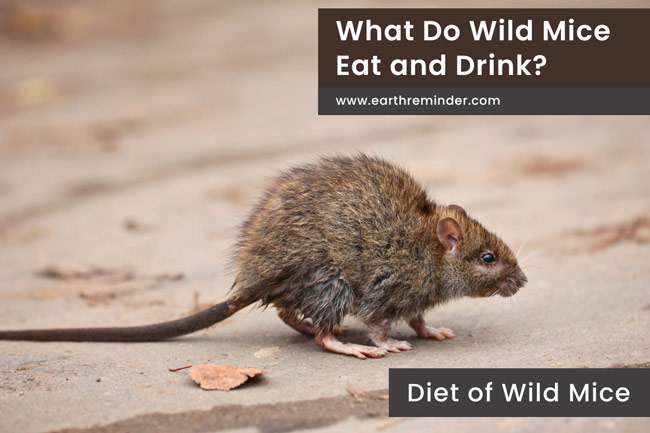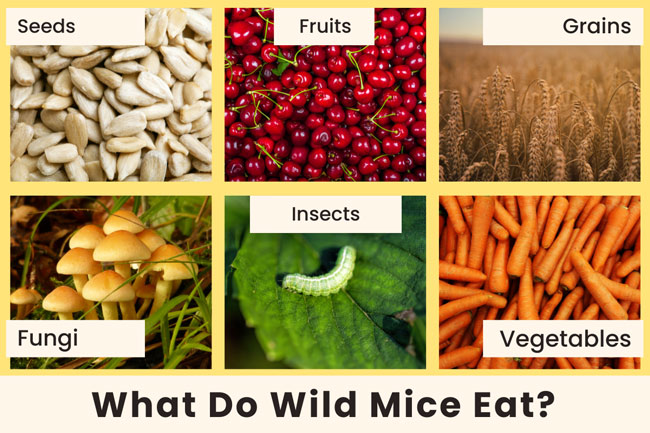What Do Wild Mice Eat and Drink? – Wild Mice Diet
When we think of wild mice, we imagine tiny creatures running around looking for food. It’s easy to imagine mice nibbling on cheese, just like in cartoons. But what do wild mice eat? The diet of wild mice is both interesting and diverse. Their diet varies with their environment, from seeds and fruits to insects and even fungi. We can get a glimpse into their lives by understanding their diet, so let’s find out more.
Table of Contents
Introduction
What do mice in the wild actually eat? As wild mice are omnivores, most of their vegetarian food varies greatly. These versatile creatures can consume almost everything based on their environment and what is naturally available. You can find them in farms, fields, and forests where food is always available. They are nocturnal species that spend most of the day sleeping.
Wild mice usually sleep-in burrows or nests during the day and search for food at night. Mice are famous for nibbling. They can survive for days on a small amount of food and often eat whatever provides the greatest energy while requiring the least amount of work to acquire.
Wild mice are opportunistic eaters and will consume nearly anything. Yet, they mostly choose seeds and grains because they are plentiful, simple to find, and packed with vitamins and nutrients that will keep them alive. Mice eat leaves, bark, mushrooms, fruits, insects, carrion, and readily available wild food. Let’s look at the wild mice diet in detail.
What Do Mice Eat in The Wild?
Mice can’t be picky eaters because they are very adaptable creatures. Mice will change their food based on what is naturally available during each season or even in their surroundings. Wild mice eat seeds, grains, nuts, fruits, vegetables, meat, and milk. Let’s explore in depth:
Seeds and Grains
Every kind of plant in fields, including yards, can produce seeds in great quantities. The wild mice eat seeds and grains from grasslands, forests, and often from agricultural areas. They prefer them because they can easily obtain seeds and grains. Since mice are adapted to their environment, it is easy for them to break the hard shells of grains and seeds. The sharp teeth let them get at the nutrients inside. Their diet may include seeds and grains from flowers, fruits, or crops. A few examples of these are sunflower seeds, wheat, corn, oats, barley, and millet.
In the Winter: Seeds are packed with energy, which is essential for mice to keep warm and survive the freezing weather. As plants drop their seeds in the winter, mice feed on them. Mice store their seeds in burrows or in secret spots to ensure they have ample food in winter. This behavior is known as caching. The high-fat content in seeds is one of the reasons why they are so vital to mice. The mice need fat as a source of energy to stay active and maintain their body temperature during winter when food is hard to find.
Nuts
Mice prefer to begin building little, secret stockpiles of seeds and nuts in autumn. The nutrients mice get from nuts make them thrive in their natural environments, allowing them to survive, reproduce, and be healthy. As mice don’t hibernate in winter, the theory is that they could return to eat those stockpiles when food supplies are low. Nuts are great for storing and preserving since they retain their freshness for a long time.
Fruit and Vegetables
The mice can find fruits easily and often find them in fields or gardens. Mice have a keen sense of smell and can identify fresh fruits and vegetables in the wild. They eat fruits such as berries, apples, pears, cherries, and watermelons. These are excellent sources of energy.
They also eat leafy greens and root vegetables. Mice prefer leafy greens such as spinach, lettuce, kale, parsley, and broccoli. They also consume root vegetables like radishes, beets, potatoes, and carrots. Mice get vitamins A, K, and fiber from these vegetables.
In the Winter: Mice don’t always find fresh fruits in winter, but they sometimes run into fruit that has fallen from trees earlier in the year. These fruits might be stale, decayed, or even frozen. There are even some fruits left on the ground and covered in leaves or snow. This fruit’s sugars help mice survive the cold by giving them energy. Also, the water content in these fruits keeps them hydrated when other water sources are frozen.
Also Read: Different Types of Mice.
Meat
Mice in the wild frequently consume any available meat when they are in a desperate situation. They are too little to go hunting for meat. They are adaptable and omnivorous, not just grain-eaters. Their natural habitat includes some meat as part of their diet. So, they eat meat too, besides plants and seeds. Their meat sources mainly include small insects (like beetles and caterpillars), worms, and even the carcasses of dead animals they find. Sometimes they also scavenge on bigger dead animals. They get essential nutrients from these sources.
Mice are “nibblers” and may make 20-30 rounds to different food sites each night. It is also common for neighboring mice to consume nearby young mice as a last resort, it also lessens competition for food in the future.
Milk
Mice don’t drink milk in the wild. Mice pups drink milk when they’re very young, but it comes from their mother. Baby mice are completely deaf, blind, and dependent on their mother for nourishment during this period. A mother mouse makes this milk to give her pups the nutrients they need to grow. A mouse’s maternal instincts make her a protective animal for her family and young ones. The pups don’t usually drink milk after they leave the nest and find their own food. It’s a true fact that wild mice will never find cow’s milk or any other type of milk out in nature. So, milk is not a typical part of an adult wild mouse’s diet.
Fungi
A wild mouse will feed on mushrooms that grow on trees or the ground. The fungi provide nourishment and hydration for mice, especially when water sources are frozen. We usually think of mushrooms when we hear the word “fungi,” but it’s just one type. Some fungi even grow underground, called mycorrhizal fungi, and these can be eaten by mice too. For example, voles consume mycorrhizal fungi.
What Do Wild Mice Drink?
Mice in the wild consume water in the same way as pets and fancy mice. There are no refilled water bottles in the outdoors. Just like humans, water is essential for their survival. Because they must fend for themselves, wild mice were exceptionally adept at survival, even in a dry, hot climate. Any available supply of water will suffice for them. They can survive on only a small amount of water. They can lick tiny water droplets from leaves and grass in the morning. Mice obtain a large portion of their hydration from the meals they eat such as fruits, insects, and plants.
Also Read: Why Wild Animals Should Not Be Kept as Pets?
Conclusion
Wild mice have a diverse diet that reflects their ability to adapt to different environments and seasons, especially winter. Their favorite food is seeds, fruits, and insects, which provide them with essential nutrients. Sometimes they eat plants, fungi, and even small creatures. But their diet can be affected by how they live and what’s available. By eating various foods, they get a balance of vitamins, minerals, and energy sources. Wild mice can scavenge for food in gardens, fields, and even buildings when they live close to people. You might find them eating leftover pet food, kitchen leftovers, and grains meant for livestock. So, wild mice can eat just about anything nature provides, whether it’s in our backyards, gardens, fields, or forests.

